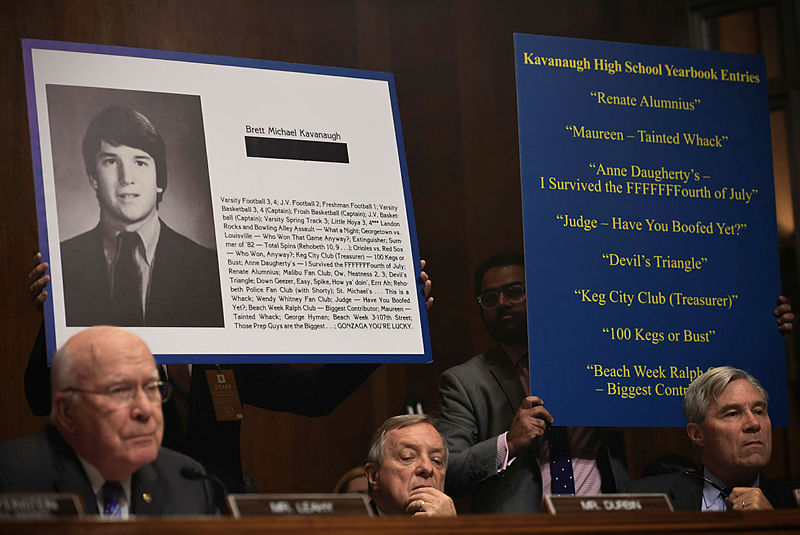WASHINGTON: Hidden away in dusty drawers or stuffed in boxes long forgotten in the attic, a danger lurks for US politicians: their yearbooks.
Often featuring the frat boy humour – or worse -- of their youthful selves, the collections of old photos and writings are coming back to haunt America’s elected leaders.
The latest high-profile victim has been Virginia’s Democratic Governor Ralph Northam, whose medical school yearbook featured a photograph of a person in blackface next to another dressed in a Ku Klux Klan robe and hood.
As pressure mounted on him to quit, one of the men in line to replace him, Virginia’s attorney general Mark Herring, admitted that he too had painted his face black in his school days.
The scandal came just months after Brett Kavanaugh almost saw his nomination to the Supreme Court derailed by allegations of sexual assault when he was in high school, a charge that led to his school yearbook being gone over with fine-toothed comb.
Yearbooks – relics of a pre-digital age when people wrote postcards and took photos on actual cameras, rather than posting on social media – feature pictures of classmates and parties, school trips, fraternities and moments of sporting glory.
Students usually have a personal page where they pose with their best friends, reminisce about their school days, or feature dedications or verse.
White coats, white hoods
In the 1984 yearbook of the Eastern Virginia Medical School, there are plenty of pictures of young interns in white doctors’ coats, smiling at each others’ waiting room quips.
But there are also images of the white robes and pointed hoods used by the KKK, a racist organisation that terrorised black communities in the American South.
Northam’s page features a picture of someone in KKK attire, standing next to another person in blackface, the makeup used once used to mock and belittle African Americans.
After initially admitting he was in the picture, the governor then denied he was one of those in the image.
He has resisted mounting pressure from his own party to resign, yet seems unlikely to survive in his post for long.
The scandal has prompted a wave of scrutiny of yearbooks from past decades, bringing other similarly racist material to light.
Kavanaugh’s high school yearbook was dusted off last September during confirmation hearings after President Donald Trump nominated the conservative judge to the highest court in the land, prompting a California professor to accuse him of having sexually assaulted her when she was 15 and he was 17.
The allegations brought his yearbook – from an expensive Catholic school in Bethesda, just outside the capital Washington – under humiliating scrutiny, bringing to light the binge drinking and sexual mockery of female classmates that the wealthy schoolboys indulged in.
The yearbook convinced many critics that he did not have the right character to take a seat on the Supreme Court, and the case split the country before Kavanaugh was finally nominated, after a tearful defense before Congress.
He joined eight other justices on the bench, including Sonia Sotomayor, who was herself criticised during her confirmation hearings because in her Princeton yearbook, she had quoted Norman Thomas, a former presidential candidate who ran on a Socialist Party ticket.
The exhumation of these yellow-paged mementos has raised the question among political observers: is there an expiry date on the errors of youth, and is a 55-year-old to be held accountable for the actions of their 18-year-old selves?
A History of Racism
Behavior that today would meet with instant opprobrium would have quite often been unremarkable in the past, noted Philip Cohen, a sociology professor at the University of Maryland.
Students in the 1980s “were the children of people raised in the 1940s and 1950s, the era of Jim Crow segregation. They grew up with legal job and housing discrimination“, he said.
“Outside of the historically black colleges, there was no black president of a major university or college until 1995,“ he noted, adding that in 1980, “the House of Representatives was four percent black and there were no black US senators. Half of adults opposed the new federal Martin Luther King holiday in 1983.”
Back then, Cohen said, a “big difference was the acceptability of racist attitudes and behaviour.”
“If yearbooks were a way for people to show off their ‘fun’ side, it is not surprising at all that this would include the kind of racist displays that are now coming out,“ he said.
The difference these days, he said, is that now “we can force a politician to resign for being racist. That’s progress.” — AFP














